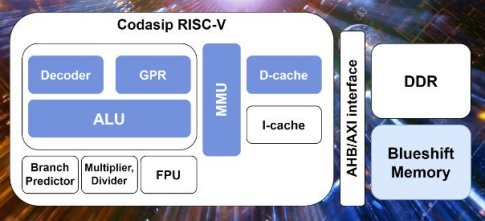Blueshift Memory to use Codasip custom compute to develop new memory-efficient processor technology
Implementing novel computer architecture in customized RISC-V core will help break through the ‘memory wall’ in data-intensive applications
Cambridge, UK — March 9, 2023 — Blueshift Memory, designer of a novel proprietary high-speed memory architecture, has announced that it is using Codasip Studio tools to integrate RISC-V processor IP into an FPGA-based design for memory architecture, modifying the Codasip core to maximize memory bandwidth.
“This is a very exciting development for us, as it will be the first time our ground-breaking Cambridge Architecture is being incorporated into a processor,” said Peter Marosan, founder and CTO of Blueshift Memory. “Codasip’s architecture licence and its unique tools give us the ability to easily customize the design to include our functionality, while still maintaining software compatibility and all the benefits of the RISC-V ecosystem. This enables us to demonstrate our potential to break through the ‘memory wall’ that is holding back performance.”
Blueshift Memory IP can be integrated into either memory chips or processors, or can be used in a stand-alone memory controller. As well as optimizing data handling in memory-intensive applications like Big Data and High Performance Computing, the technology is also capable of boosting performance in cloud data centres and in edge computing for 5G/6G.
“The faster data transfer and energy-efficient processing that are enabled by the novel Cambridge Architecture herald a real breakthrough in the way data will be handled in the future. The Codasip custom compute architecture license and Codasip Studio provide a rapid and easy-to-use route to customize a RISC-V processor, which will be a key part of that journey,” added Marosan.
In 2022 Blueshift Memory was awarded a prestigious Smart grant by Innovate UK. The 13-month project is focused on developing a module based on the Cambridge Architecture that dramatically increases memory bandwidth, and the final design will include a customized Codasip RISC-V core. As well as helping to create a memory accelerator product, the project will also enable the company to demonstrate the potential benefits of the Cambridge Architecture IP for larger system-on-chip designs incorporating RISC-V.

About Blueshift Memory
Blueshift Memory’s proprietary chip design optimizes the memory architecture for more efficient handling of large data sets and time-critical data, enabling up to 1,000 times faster memory access for specific data-focused applications. These include high performance computing, artificial intelligence (AI), machine vision for augmented and virtual reality (AR/VR), 5G edge connectivity and the Internet of Things (IoT). The focus of Blueshift Memory’s technology is the Cambridge Architecture™, the next-generation technology for stored-program machines, designed to replace the currently-used modified Harvard architecture and to overcome the traditional constraints of the von Neumann bottleneck. For more information see www.blueshiftmemory.com.
Related Semiconductor IP
- Gen#2 of 64-bit RISC-V core with out-of-order pipeline based complex
- Compact Embedded RISC-V Processor
- Multi-core capable 64-bit RISC-V CPU with vector extensions
- 64 bit RISC-V Multicore Processor with 2048-bit VLEN and AMM
- RISC-V AI Acceleration Platform - Scalable, standards-aligned soft chiplet IP
Related News
- Blueshift Memory Awarded Innovate UK Smart Grant to Develop AI Computer Vision Module
- Blueshift Memory and Crypta Labs to develop quantum-resilient cybersecurity memory module
- Blueshift Memory announces successful development of computer vision AI accelerator chip
- embedded world 2024: Codasip demonstrates CHERI memory protection
Latest News
- TSMC to Lead Rivals at 2-nm Node, Analysts Say
- Energy-efficient RF power modules developed using SOI technology
- Quintauris Demonstrates RISC-V Innovation in Automotive at CES
- UMC Reports Sales for December 2025
- Tenstorrent unveiled its first-generation compact AI accelerator device designed in partnership with Razer™ today at CES 2026